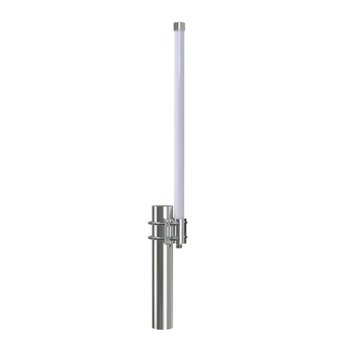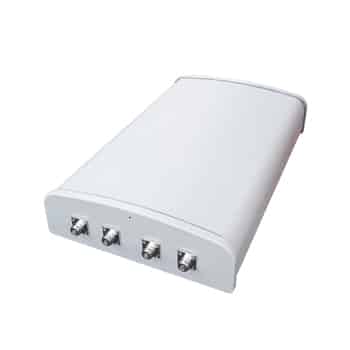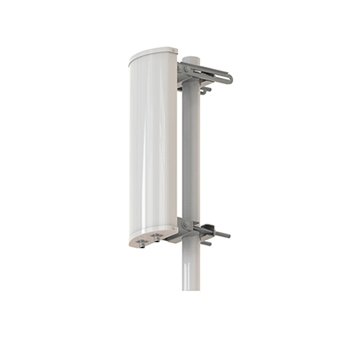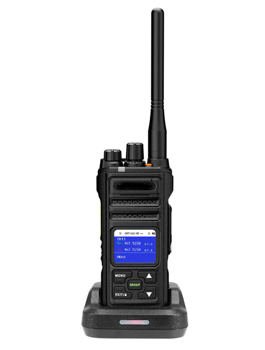
General Mobile Radio Service or GMRS is a specially designed two-way communication system to ensure coverage at small and medium range distances. While GMRS operates in the ultra high frequency (UHF) region like other radio services, GMRS (General Mobile Radio Service) stands out due to its operational characteristics, and intended applications, from helping to facilitate group activity in the outdoors to coordinating an emergency. The physical realization of all GMRS is achieved through GMRS antenna, the central elements of GMRS communication. GMRS antennas designed specifically for the GMRS frequency range ensures good signal quality and reliable connectivity making them an important component in the GMRS communication scenario.
This article aims to provide insights on GMRS focusing specifically on GMRS antennas, their functionalities, types, key features, and other parameters to make informed choices for a better communication experience
Table of Contents
ToggleWhat is GMRS and GMRS Antenna?
The General Mobile Radio Service (GMRS) operates within the UHF range of 462-467 MHz. Even though its functionality is somewhat similar to family radio service (FRS) and citizens band (CB) radio service, what sets GMRS apart is its ability to provide higher transmitter output (as high as 50 W) and the broad range of coverage ( 5- 15 miles) it offers.
Simple and easily accessible, GMRS is mostly used in personal and recreational communication with some exceptions in business and professional fields. As it is a popular choice in short range individual communication GMRS is typically governed by a regulatory framework. Especially in the United States the GMRS is a licensable service governed by the Federal Communications Commision (FCC) where users are required to apply for a license to avoid legal disputes. The obtained license is renewable and comes with a 10 year validity period covering all immediate family members without any age restrictions. Although the licensing procedure is followed in the United States it is not necessarily followed everywhere. This is quite evident in Canada where similar GMRS compatible equipment can be used without following a licensing procedure.
As GMRS falls within the UHF range, any UHF antenna can be used as a GMRS antenna. However it would require the antenna to be trimmed and tuned to the GMRS range. Therefore a standardized GMRS antenna which just needs to be installed would be an ideal hassle free choice. A properly chosen GMRS antenna can significantly improve communication clarity, range, and reduce signal dropout ensuring connectivity across a variety of applications, especially in ones where reliable communication is paramount.
How Does GMRS Antenna Work?
GMRS antennas are specialized antennas designed to operate within GMRS range with the ultimate goal of improving the performance of GMRS radios. Based on the application, they come in a variety of designs, the most common types include mobile antennas, handheld or whip antennas, base station antennas, and directionally-focused Yagi antennas.
The underlying principle of a GMRS antenna is electromagnetic radiation. The antenna converts an electrical signal from the radio into electromagnetic waves (radio waves), enabling them to travel through the air. These propagated radio waves are received by another GMRS radio equipped with an antenna tuned to the same frequency range. The received radio signal is converted back into an electrical signal, facilitating communication between two entities.
A GMRS can be paired with a GMRS repeater for the broadest possible distribution. GMRS repeaters are typically positioned at elevated locations in the service area. This makes it easier for them to receive and rebroadcast the received signals without the potential disturbances caused by obstructions found at ground level, making them effective range enhancers. Coupling a GMRS with a repeater can significantly enhance its coverage from several miles to several tens of miles.
Key Features of GMRS Antennas
Even though they come in different designs, GMRS antennas consist of several generic key features that set them apart from other antenna types. These features include,
- Frequency Range
GMRS antennas operate in the UHF range of 462-467 MHz, which are divided to 30 frequency channels. These channels comprises of 16 main channels and 14 interstitial channels. The 8 main channels around 467 MHz can be only used as repeater inputs whereas the 8 main channels around 462 MHz can be used as either repeater outputs or in simplex communication.
- Antenna gain
Antenna gain acts as critical measure on an antenna’s ability in directing radio energy, compared to an isotropic radiator. The gain of a GMRS antenna mostly varies between 2.1 dBi to 7.5 dBi. Higher gain antennas can transmit signals further and enhance signal strength, making them ideal for communication over distance.
- Antenna polarization
Antennas can be vertically or horizontally polarized, indicating the orientation of the electromagnetic waves they transmit or receive. Vertical polarization is commonly used for GMRS communication, particularly in mobile and base station antennas. Choosing the right polarization is crucial for minimizing signal loss and ensuring clear communication.
- SWR (Standing Wave Ratio)
SWR measures the effectiveness of the transmission line and matching between the antenna and the radio. A lower SWR indicates that most of the power supplied to the antenna is effectively radiated as a radio wave. High SWR values indicate losses; therefore, selecting an antenna with a low SWR rating ensures efficient communication and performance.
Types of GMRS Antennas
As there are a variety of GMRS antennas, they provide users with multiple options for a variety of applications. Given below are some of the most commonly used GMRS antennas with their applications:
- GMRS Mobile Antennas
Mobile GMRS antennas are compact yet flexible structures that have been specifically designed to be mounted on vehicles. These antennas feature a variety of mounting options, such as magnetic, lip, mirror, and drill mounts which can be selected based on vehicle size and application type. These types of antennas are commonly used for everyday tasks like family road trips, outdoor community events, and emergency communication and feature a moderate gain between 3 – 5 dB to ensure a balance in size and performance.
- GMRS Handheld Whip Antennas
These antennas are short and durable and have been designed to be compact in order to ensure portability. Often attached to handheld GMRS radios they provide excellent mobility, which makes them an essential choice for enthusiasts such as hikers, campers, and small business owners. Even though their coverage is often less than mobile GMRS antennas and base station GMRS antennas, these antennas are a great choice for communication while on the go, providing immediate connection regardless of remoteness.
- GMRS Fiberglass Base Station Antennas
These antennas are made from fiberglass material which makes them a durable option to operate in adverse weather conditions. Providing a higher gain ( somewhat higher than 9dBi) these antennas are more suited for communication in open areas across long distances. Mounted on rooftops or towers, fiberglass base station antennas offer extended communication ranges, making them ideal for rural homes or community networks. Even though they provide excellent durability and performance, these antennas are relatively more expensive and more complex to install compared to other GMRS antenna types.
- GMRS Yagi Antennas
The GMRS Yagi antennas are designed with a directional focus which allows them to concentrate on signal strength in a specific direction. Constructed using lightweight durable materials, GMRS Yagi antennas offer high gain capabilities (ranging from 7dBi to 13 dBi ) making it ideal for long-distance, point to point communications. These antennas are generally mounted on masts,poles or rooftops and their performance greatly relies on precise alignment. They are useful in accessing distant repeaters or forming communication links between fixed locations such as home base and remote locations especially in line of sight conditions.
Antenna Gain and Performance
Antenna gain measures how effectively an antenna focuses and directs radio waves in a specific direction. It is measured in decibels relative to an isotropic radiator – a theoretical point source that emits radiations in every direction with equal intensity.
Another consideration that goes along with antenna gain is its beamwidth. Antenna beamwidth denotes the angular separation between the points at either side of antenna boresight where the gain of the antenna is at a half from its maximum. The beamwidth and gain are inversely proportional constraints that as gain increases , the beamwidth decreases, also decreasing the effective area covered by the antenna.
A positive dB value indicates an increase in power or strength of the transmitted signal. For example a 3dB gain would double antennas effective radiated power an increase of 6dB would quadruple the effective radiated power.
Therefore higher gain antennas are ideal for transmitting signals over long distance communication with minimal obstructions. However, this does not make low gain antennas any less effective. Low gain antennas are able to cast a taller signal, which makes them ideal for heavily obstructed urban areas such as cities and dense forests. Antennas offering a medium gain are much suited for areas with some amount of obstructions such as scattered hills and trees.
Therefore, when choosing antennas for applications both appropriate gain rating and environment need to be considered for a better overall performance.
Benefits of Using a GMRS Antenna
- Improved Signal Range and Clarity
Utilizing GMRS (General Mobile Radio Service) antennas offer a transmitting range of several tens of miles which can further be improved by use of GMRS repeaters. Furthermore high-gain antennas, such as Yagi antennas, designed to focus in a specified direction can effectively minimize interference and enhance communication clarity. This is crucial in environments with many obstacles, such as urban areas or densely populated spaces, where signal distortion is common.
- Reliable Communication in Remote Areas
For users in remote or rural locations where cellular coverage is unreliable or nonexistent, GMRS antennas are invaluable. GMRS radios paired with high-performance antennas provide a dependable means of communication over long distances, making them ideal for outdoor enthusiasts, hikers, and workers in fields such as forestry or conservation.
- Enhanced Durability for Outdoor Use
Many GMRS antennas are designed to be durable, making them a good candidate for outdoor use. Antennas made from durable materials such as fiberglass or heavy-duty aluminum can withstand harsh weather conditions, including rain, snow, and strong winds. Also some GMRS antenna models feature UV-resistant coatings to prevent degradation from extended sun exposure, ensuring reliable performance and longevity.
- Versatility for Various Applications
GMRS antennas are versatile and not limited to emergency communication or personal use. They can be utilized effectively in several scenarios, including family gatherings, camping trips, and professional settings like construction sites, event management, or community networking. Their adaptability makes GMRS antennas a practical choice for various applications, facilitating communication across diverse environments.
- Cost-Effectiveness
When compared to traditional communication methods, such as cell phones or satellite phones, GMRS radios and antennas offer a more cost-effective solution for reliable communication. Even though there is an initial investment in GMRS equipment, it results in significant long-term savings, particularly for organizations or communities that require consistent communication as there won’t be any incurred monthly service fees.
Overall, GMRS antennas provide an effective blend of performance, durability, and cost-efficiency, making them a valuable investment for a variety of communication needs.
Applications of GMRS Antennas
The versatility of GMRS (General Mobile Radio Service) antennas underscores the critical role they play across a variety of applications. Some of their use cases include :
- Emergency Communication
During natural disasters or emergencies, GMRS antennas play a vital role in facilitating communication among response teams. When traditional communication networks—such as cell towers—fail due to infrastructure damage, GMRS systems maintain operability, ensuring that rescue and recovery efforts can be coordinated effectively. Their ability to establish reliable channels of communication even under adverse conditions makes GMRS a preferred choice for emergency management agencies.
- Outdoor Activities
For outdoor enthusiasts—whether it’s hiking, camping, off-roading, or hunting—GMRS antennas are essential for keeping in touch with friends and family. This is particularly important for remote areas where cell phone coverage is limited or nonexistent. By enabling constant communication, GMRS antennas enhance safety during outdoor expeditions, allowing users to share real-time updates about their locations and conditions, which can be crucial in case of emergencies.
- Rural and Agricultural Use
Farmers and rural communities significantly benefit from GMRS communication systems. These systems enable efficient coordination for various daily tasks, such as livestock monitoring, crop management, and emergency response efforts in expansive agricultural lands. GMRS radios can cover larger areas without the need for expensive infrastructure, making them an effective choice for agrarian settings.
- Vehicle-to-Vehicle Communication
When traveling in caravans, boating, or participating in off-road excursions, GMRS antennas are essential for maintaining effective vehicle-to-vehicle communication. They enable users to coordinate movement, share safety protocols, and exchange important information in real-time, enhancing the overall travel experience. GMRS radios are favored in these contexts due to their long-range and reliable performance compared to other communication methods.
- Base Stations for Community Networks
Especially in rural or isolated regions, GMRS antennas facilitate the formation of community communication networks. These localized systems allow residents to communicate efficiently, share resources, and coordinate community efforts without relying on commercial cellular networks which might not be available or efficient. Such networks can be especially beneficial during local events or in emergencies when prompt information dissemination is crucial.
- Industrial Applications
In industries such as mining, utilities, and construction, GMRS antennas ensure effective communication among crews working in remote locations. Reliable communication systems are essential in these sectors to facilitate collaboration, promote safety measures, and respond quickly to potential hazards or emergencies. GMRS equipment’s ease of use and coverage capabilities make it an optimal choice for managing operations in these type of challenging environments.
- Military and Public Safety
GMRS radios and antennas are able to provide secure communication channels essential for military operations and public safety agencies. Coupled with privacy codes (also known as CTCSS or DCS codes), GMRS radios help in creating robust communication networks that enhance coordination and response efforts during critical missions. The reliable nature of GMRS systems allows for immediate coordination across various units, which can be crucial in situations requiring rapid responses or strategic planning.
Choosing the Right GMRS Antenna
When selecting a suitable GMRS (General Mobile Radio Service) antenna, several factors must be considered,
1. Purpose of Use
- Mobile Use: If you need a GMRS antenna for a vehicle or portable application, consider antennas designed for mobility that can withstand the rigors of travel.
- Base Station Use: For stationary setups, base station antennas typically offer better range and signal clarity, making them ideal for consistent communication needs.
- Handheld Radios: If using handheld GMRS radios, ensure that the antenna is lightweight and compatible with the device without compromising performance.
2. Antenna Type
Different types of antennas serve unique purposes, each optimized for specific conditions:
- Whip Antennas: Common for handheld radios, they provide decent range and are compact.
- Base Station Antennas: These larger antennas can provide enhanced range and clarity for stationary setups, making them suitable for community or emergency communication.
3. Directional vs. Omnidirectional
- Directional Antennas: Designed to focus the signal in a specific direction, these antennas can significantly enhance communication range in that direction but may not pick up signals from other angles. They are ideal for point-to-point communications, such as connecting two fixed stations.
- Omnidirectional Antennas: These antennas broadcast and receive signals in all directions. Ideal for mobile use or situations where communication is needed from multiple angles, they maintain consistent performance in varying environments.
4. Terrain Considerations
- Urban Areas: These environments often present challenges such as signal obstructions from buildings and other structures. Directional antennas may be beneficial for targeting communications across such obstacles.
- Open Areas: Here, omnidirectional antennas can be very effective, allowing for broad coverage without the need for precise alignment.
5. Frequency Matching
GMRS antennas should be tuned for the GMRS frequency range of 462-467 MHz. Using antennas not specifically tuned for these frequencies can result in poor performance, including reduced range and increased signal loss. Always check the specifications to ensure compatibility.
6. Mounting Location
For vehicles, antenna location significantly impacts performance. Roof-mounted antennas or those with magnetic bases typically offer optimal results due to the height and reduced interference. Consider using a spring mount to reduce the likelihood of antenna breakage due to branches or other obstacles.
7. Antenna Gain
Antenna gain is measured in dBi (decibels relative to isotropic) and indicates the efficiency of the antenna in focusing signal strength. Higher gain antennas can provide extended range, particularly beneficial in weak signal areas. However, note that higher gain often means a more directional signal.
8. Material and Build Quality
The material and construction quality of an antenna can affect durability and performance. Look for antennas made from robust materials such as stainless steel, fiberglass, or heavy-duty plastics that can withstand environmental stressors and resist corrosion.
9. Weather Resistance
Select GMRS antennas designed with weather resistance in mind, particularly if they will be used outdoors. Look for features such as UV protection, waterproof designs, and rugged construction to ensure longevity and reliable performance under various conditions.
10. Connector Type
To ensure compatibility between your antenna and GMRS radio, check the connector type. Common connectors include:
- SMA (SubMiniature version A): Typically used in handheld and portable devices.
- BNC (Bayonet Neill-Concelman): Common in mobile applications.
- N-type: Often found in base station applications due to its durability and low loss.
Installation Basics for GMRS Antenna
Proper installation of GMRS antennas is critical to achieving optimal performance. Here are key installation practices:
- Optimal Placement: Mount the antenna as high as possible to improve line-of-sight communication. Avoid placing the antenna near obstructions that could cause signal interference.
- Grounding Considerations: Implement proper grounding techniques to protect the antenna system from lightning strikes and electrical surges. Grounding also enhances the overall performance by reducing noise and interference.
- Cable Routing: Use appropriate cable lengths and route cables away from electrical sources to minimize interference. Ensure that the cable connections are secure to prevent faults in performance.
- Angle Adjustments: For directional antennas, carefully angle the antenna toward the target transmission area, optimizing gain based on the communication needs.
- Regular Maintenance: Conduct regular checks to ensure connections, grounding, and structural integrity remain intact over time. Any signs of wear and tear could affect overall performance.
Mounting Options for GMRS Antennas
Choosing the right mounting option for a GMRS (General Mobile Radio Service) antenna plays a crucial role in enhancing signal performance and overall usability.
1. Vehicle-Mounted Options
For mobile communication, vehicle-mounted antennas are popular due to their practicality and performance. These options are designed for seamless installation and ease of use while on the move:
- Magnetic Mount:
A magnetic base attaches securely to metal surfaces like a car roof. It’s quick to install and remove, making it ideal for temporary setups or users who switch vehicles frequently. - Lip Mount:
Clamps onto the edge of vehicle panels, such as the trunk, hood, or door. It’s a sturdy choice that avoids permanent modifications, combining convenience with stability. - Mirror Mount:
Attaches to the brackets of side mirrors, commonly used on larger vehicles such as trucks, RVs, or vans. This mount ensures the antenna is well-positioned for better signal performance. - Drill Mount:
A permanent installation method requiring drilling into the vehicle’s surface. Though more labor-intensive, it provides maximum stability and is suitable for users who prioritize a long-term solution.
2. Roof or Mast Installations
For fixed setups, mounting antennas on rooftops, towers, or masts offers superior performance by increasing height and minimizing obstructions. This configuration is ideal for stationary base stations, enabling:
- Enhanced line-of-sight communication: Higher elevation helps reduce interference from buildings, trees, or terrain.
- Broader coverage areas: Perfect for maximizing signal reach in urban or rural environments.
3. Portable Mounts
For handheld or temporary setups, portable mounting options offer unmatched flexibility. These mounts allow users to adapt to changing environments by placing the antenna wherever it’s needed most. This versatility makes them an excellent choice for camping, outdoor events, or emergency situations.
Selecting a mounting option tailored to a specific application ensures optimal signal performance and reliability. Whether you’re on the move, setting up a base station, or need a portable solution, the right mount helps you make the most of your GMRS communication system.
GMRS vs. Ham Antennas
Understanding the differences between GMRS (General Mobile Radio Service) and ham (amateur) radio antennas is crucial for choosing the right system based on communication needs some of their distinctions include:
1. Design and Purpose
- GMRS Antennas: Specifically designed for two-way communication over short- to mid-range distances, GMRS antennas are typically optimized for simplicity and ease of use, making them suitable for family, recreational, or small-group communication.
- Ham Radio Antennas: These antennas are more versatile and cover a broader range of frequencies and applications. Depending on the band and antenna type, ham antennas can support local, regional, or even global communication. Ham radio operators often customize their antenna setups for specific needs, including long-distance (DX) communication and experimentation.
2. Frequency Range
- GMRS Antennas: Operates exclusively within the 462-467 MHz range, covering specific GMRS channels in the UHF (Ultra High Frequency) spectrum. This narrow focus simplifies their design and tuning.
- Ham Radio Antennas: Capable of transmitting across multiple bands, including HF (High Frequency), VHF (Very High Frequency), and UHF (Ultra High Frequency), depending on the operator’s license class. This versatility allows ham antennas to handle a wide variety of communication scenarios, from short-range to global transmissions.
3. Licensing Requirements
- GMRS:Requires a license issued by the FCC (Federal Communications Commission) in the United States, but obtaining one is straightforward and does not require passing an exam. A single GMRS license covers the entire family of the licensee.
- Ham Radio:Licensing involves passing examinations that test knowledge of regulations, technical concepts, and operating procedures. There are multiple licensing levels (e.g., Technician, General, and Amateur Extra), each granting access to additional frequencies and privileges.
4. Choosing Between GMRS and Ham Systems
- GMRS: Ideal for users who need a reliable and straightforward communication system for personal, recreational, or family use. GMRS antennas and systems are easy to set up and operate with minimal technical expertise.
- Ham Radio: Suited for hobbyists, experimenters, and who require greater flexibility in frequency range and applications. Ham radio offers advanced communication capabilities, but it requires more technical knowledge and commitment.
Both GMRS and ham radio systems have their strengths, and the choice depends on the specific communication needs, level of technical interest, and licensing preferences.
Conclusion
In conclusion, GMRS antennas serve as a crucial component in establishing reliable communication across various applications. By selecting the right GMRS antenna, users can maximize their communication abilities, enabling them to stay connected during outdoor activities, emergencies, and diverse scenarios. Furthermore investing in quality GMRS antennas is pivotal for optimal performance and effective connectivity, making them invaluable tools for anyone involved in two-way communication.








